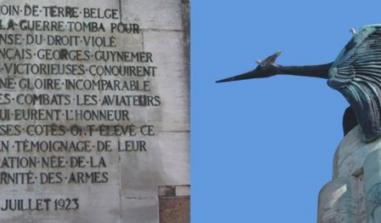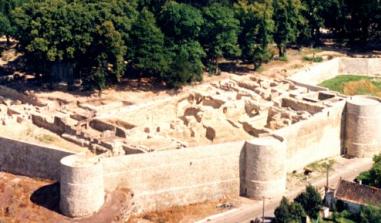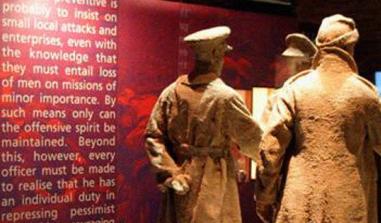Yser Tower

Yser Tower. Source: IJzertorenmuseum Diksmuide
The Yser Tower was erected in memory of the Flemish soldiers killed during the First World War.
A monument to peace
Located in the Belgian town of Diksmuide, the Yser Tower, erected in memory of the Flemish soldiers killed during the First World War, is the tallest peace monument in Europe. It houses a museum and a chapel.
On 4 August 1914, Belgium was invaded and, despite the resistance of the Belgian army against the German troops, the push was stronger after the Battle of the Marne.
On 10 October, the fall of Antwerp threatened the allied front: it was then decided by the command to establish a front running along the River Yser from Diksmuide all the way to the sea and to hold it.
This flat region of plains was the stage for one of the final confrontations of the “Race to the Sea” period. From 18 to 26 October 1914, the two armies fought and waged battle upon battle. At the end of the month, to avoid a breakthrough in the front, the Allies and King Albert I of Belgium flooded a part of the plain in order to put a definitive stop to the German advancement. This decisive battle in the month of October 1914 would progressively become a key event in Flemish remembrance after the war.
At the very start of the conflict, King Albert of Belgium made a proclamation to the “nation’s army”, urging the Walloon and Flemish populations to come and fight under the united flag of Belgium: “Do you remember, Flemish, of the Battle of the Golden Spurs?” This call to action was interpreted by many soldiers as a tacit affirmation of the Flemish identity and recognition of the Dutch language. But during the four years of war, a split formed between the two communities. Most of the French-speaking officers expressed themselves in French while the Flemish soldiers could not speak the language.
Many paid their inability to understand orders with their lives.
At the end of this conflict, 70% of victims were Flemish. A Front Movement was established among the soldiers who had written an open letter to the king – the Yser Testament – considered as a founding act of the remembrance policy that would be pursued over the following decades. From 1920, to honour the memory of Flemish soldiers killed during the war, pilgrimages were organised each year and a monument was erected: the Yser Tower, surmounted by a cross, and inaugurated on 24 August 1930. It was demolished during a dynamite attack in 1946. Five years later, a gate of peace inscribed with the word “Pax” was built from the remains of the old tower.
It wasn’t until 1965 that a new tower, 84 metres tall, was inaugurated. The initials AVV-VVK are inscribed at the top of the tower, letters that mean “All for Flanders-Flanders for Christ”. The inscription "Never again war" is also written on the tower in Belgium’s four main languages (Dutch, French, English and German). A peace monument, the Yser Tower, is first and foremost a place of commemoration for the Flemish soldiers killed during the First World War, which then became a beacon of the Flemish nationalist movement.
In 1997, the entire structure and the crypt, in which lay nine Flemish soldiers and a Walloon soldier, were restored. On the 10-hectare site, a “Footbridge of Hope”, a reconstruction of a bridge used by the infantrymen to move from the first line to the outpost – is open to visitors. Inside the tower, the 22-storey Ijzertoren or Yser tower museum displays temporary exhibitions as varied as “underground life at the front”, “mud”, “art on the front line” and "animals during wartime”.
The permanent exhibition, meanwhile, retraces the history of the two world wars and the interwar period. Two floors are dedicated to the history of Flanders. On the ground floor, a chapel houses the stained-glass windows designed by Eugeen Yoors and Yan Wouters and a film (Violence Never Brings Peace) is played continuously in the auditorium. Guided tours and educational activities are regularly organised. In the late 1990s, the museum’s work was internationally recognised and it joined the United Nations’ International Network of Museums for Peace. In 2004, the museum extended its focus to ethnic and cultural minorities who make up Flanders today, in response to the soldiers’ wish in 1914: the respect of particularism.
Yser Tower
VZW Ijzertorenmuseum Ijzerdijk 49 8600 Diksmuide (Belgium)
Tel: +32 051 / 50 02 86
Practical information
Ijzerdijk 49 8600
Diksmuide
Tél. 051 / 50 02 86
Adultes : 7€ Groupe (+20 pers.) :5€ Adults: €7 Group (20 or more pers.): €5 Over 65s: €5 Under 26s: 1€ Children go free (aged 0-6) Tower guardian (1 hour): 25€ Guide (2 hours): €50
open daily except the three weeks after the Christmas holidays.




